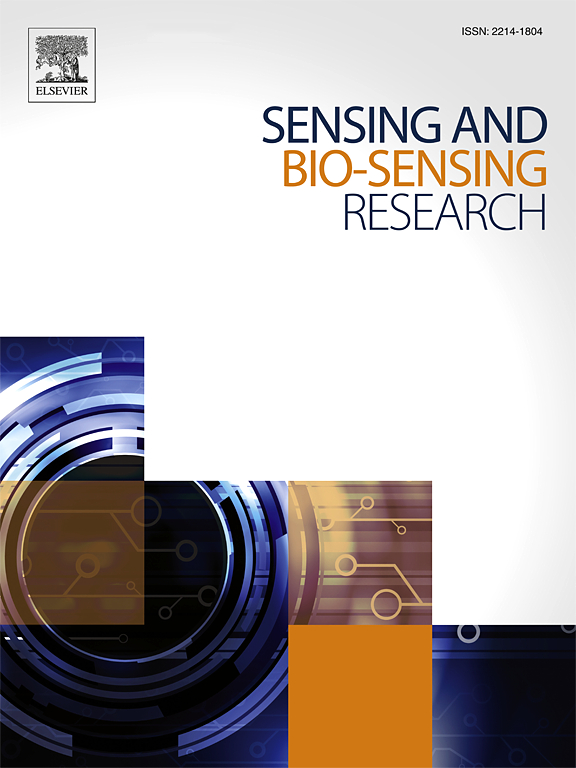Simple introduced in/on preformed macrocyclic ligands with imidazole groups as new platform linkers in metal-organic frameworks material: Application in electrochemical sensing Losartan
IF 5.4
Q1 CHEMISTRY, ANALYTICAL
引用次数: 0
Abstract
In this paper, macrocycle compounds containing nitrogen and oxygen groups were synthesized via template condensation of o-phenylenediamine with various aromatic dicarboxylic acids. In the following stage, to create an appropriate linker for the formation of metal-organic frameworks (MOFs), the obtained macrocyclic compound was reacted with 4-chloro 2-methylimidazole derivatives in a straightforward reaction. A new metal-organic frameworks (MOFs) was formed by the interaction of Co (II) ions with a macrocyclic ligand, specifically the Zeolitic imidazolate framework macrocyclic ligand metal-organic frameworks (ZIF-MLMOFs). The synthesized compounds were thoroughly characterized using various physicochemical methods, including melting point determination and elemental analysis techniques such as XRD, NMR, and FT-IR spectroscopy. The results obtained were consistent with the proposed structures. In order to apply the synthetic material, the electrochemical technique was used for investigation of Losartan (LOS) drug sample. Subsequently, the catalytic activity of ZIF-MLMOFs/Nf/GCE was characterized by cyclic voltammetry (CV) and chronoamperometry (CA) for the oxidation of LOS in PBs media. The diffusion coefficient of LOS was found to be (DLOS =7.94×10−6 cm2 s−1) and the catalytic rate constant was measured as (kcat = 1.75×106 cm3 mol−1 s−1). Differential pulse voltammetry (DPV) exhibited a linear response range of 1.99–100 μM with a limit of detection of 0.76 μM. The electrochemical sensor exhibited exceptional selectivity and sensitivity, along with reproducibility and repeatability, which can enhance the application of MOFs in drug electrochemical sensors.
简单介绍了以咪唑基为新型平台连接体的金属有机骨架材料的内/上预构大环配体:电化学传感氯沙坦的应用
本文以邻苯二胺和各种芳香二羧酸为原料,通过模板缩合合成了含氮、氧基团的大环化合物。在接下来的阶段,为了生成合适的金属有机框架(mof)的连接体,将得到的大环化合物与4-氯- 2-甲基咪唑衍生物直接反应。通过Co (II)离子与大环配体的相互作用,形成了一种新的金属-有机骨架(MOFs),即沸石型咪唑酸盐骨架大环配体金属-有机骨架(ZIF-MLMOFs)。合成的化合物使用各种物理化学方法进行了彻底的表征,包括熔点测定和元素分析技术,如XRD, NMR和FT-IR光谱。所得结果与所提出的结构一致。为了应用该合成材料,采用电化学技术对氯沙坦(LOS)药物样品进行了研究。随后,采用循环伏安法(CV)和计时安培法(CA)对zif - mlmfs /Nf/GCE在PBs介质中氧化LOS的催化活性进行了表征。得到LOS的扩散系数为(DLOS =7.94×10−6 cm2 s−1),催化速率常数为(kcat = 1.75×106 cm3 mol−1 s−1)。差分脉冲伏安法(DPV)的线性响应范围为1.99 ~ 100 μM,检测限为0.76 μM。该电化学传感器具有良好的选择性和灵敏度,同时具有重现性和可重复性,可促进mof在药物电化学传感器中的应用。
本文章由计算机程序翻译,如有差异,请以英文原文为准。
求助全文
约1分钟内获得全文
求助全文
来源期刊

Sensing and Bio-Sensing Research
Engineering-Electrical and Electronic Engineering
CiteScore
10.70
自引率
3.80%
发文量
68
审稿时长
87 days
期刊介绍:
Sensing and Bio-Sensing Research is an open access journal dedicated to the research, design, development, and application of bio-sensing and sensing technologies. The editors will accept research papers, reviews, field trials, and validation studies that are of significant relevance. These submissions should describe new concepts, enhance understanding of the field, or offer insights into the practical application, manufacturing, and commercialization of bio-sensing and sensing technologies.
The journal covers a wide range of topics, including sensing principles and mechanisms, new materials development for transducers and recognition components, fabrication technology, and various types of sensors such as optical, electrochemical, mass-sensitive, gas, biosensors, and more. It also includes environmental, process control, and biomedical applications, signal processing, chemometrics, optoelectronic, mechanical, thermal, and magnetic sensors, as well as interface electronics. Additionally, it covers sensor systems and applications, µTAS (Micro Total Analysis Systems), development of solid-state devices for transducing physical signals, and analytical devices incorporating biological materials.
 求助内容:
求助内容: 应助结果提醒方式:
应助结果提醒方式:


